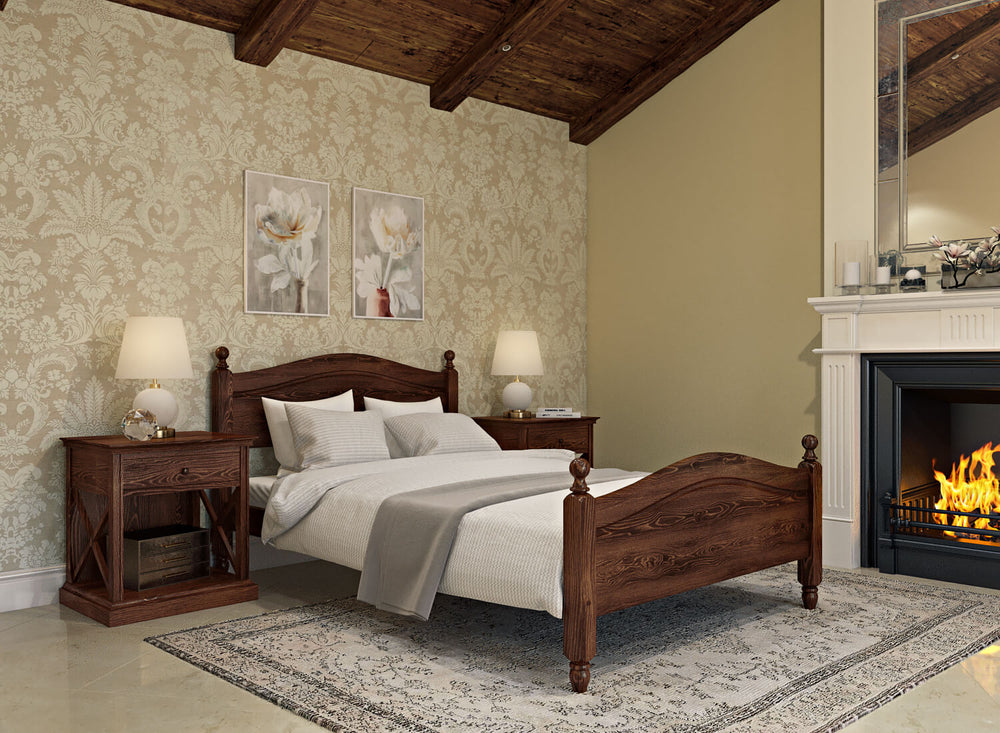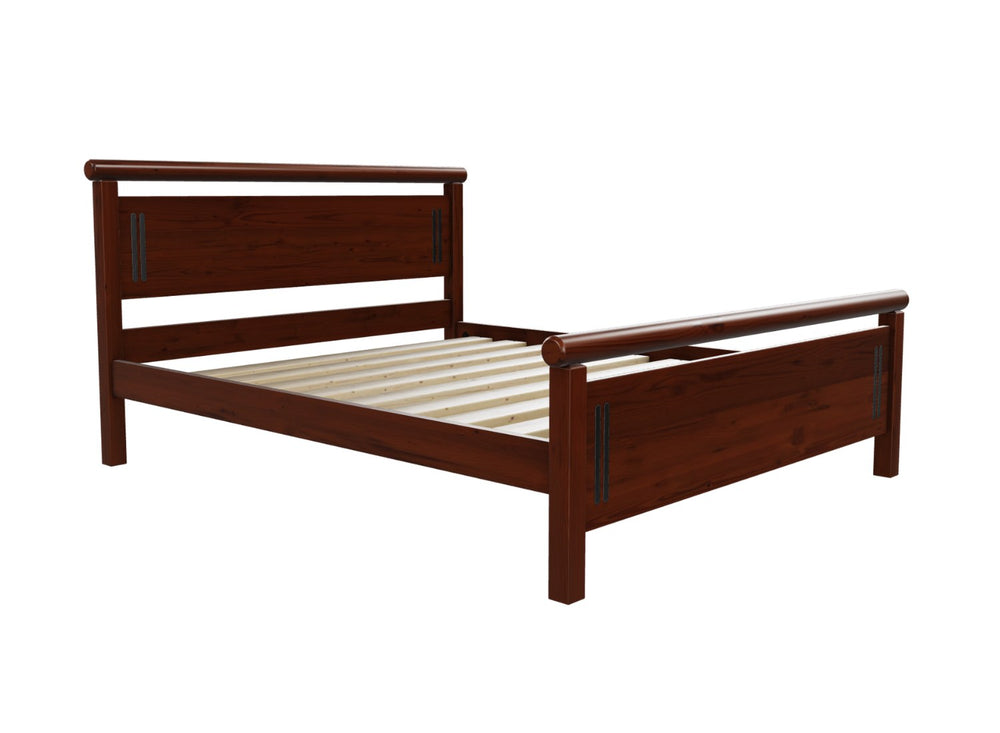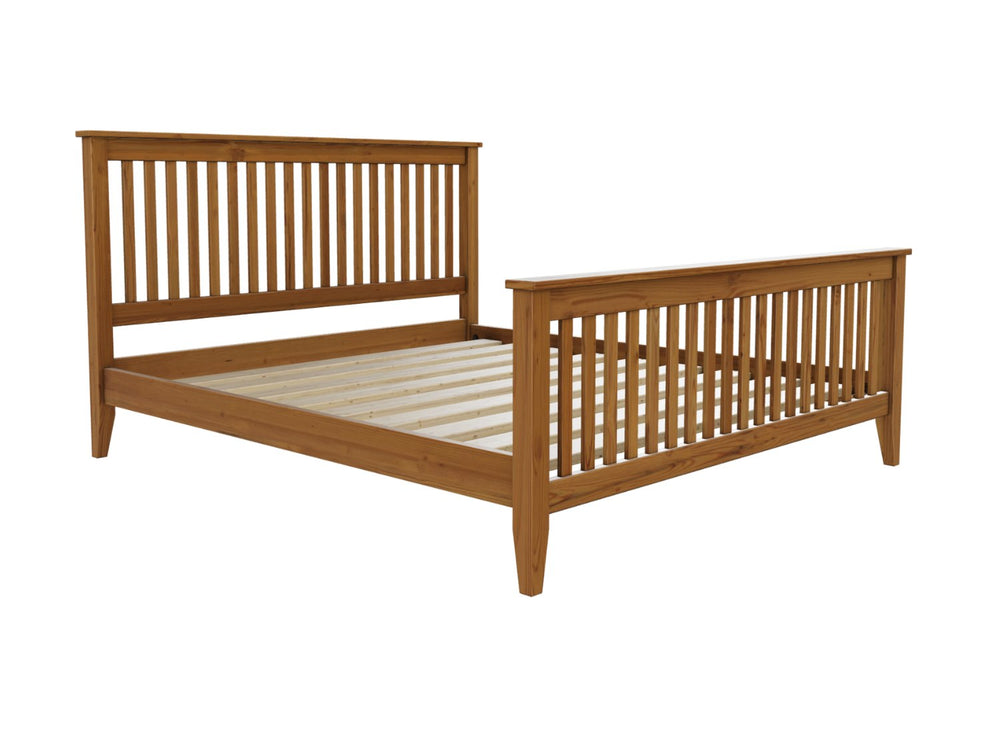
When you walk into a bedroom and lay your eyes on a beautifully crafted solid oak bed, it's easy to admire its elegance, durability, and timeless design. But have you ever wondered about the journey that bed took before it reached your home? From the careful selection of wood in a sustainable forest to the skilled craftsmanship in its construction, the process of creating a solid oak bed is a testament to dedication, expertise, and sustainability. In this blog post, we will walk you through the entire oak bed production process, from the forest to your bedroom, and explore the importance of sustainable sourcing and the furniture lifecycle.

Product: Solid Oak Coxford Bed Finished in Chocolate Brown Stain
Solid oak beds sit within the wider category of wooden bed frames, valued for their natural character, strength, and long-term durability. If you are exploring timber beds more broadly, our guide on the natural style and timeless appeal of wooden bed frames looks at why responsibly sourced wood continues to be a popular choice for well-crafted bedroom furniture.
Sustainable Sourcing: The First Step in Oak Bed Production
The journey of a solid oak bed begins in the forest, where oak trees are harvested with sustainability in mind. Oak is a hardwood known for its strength, resilience, and natural beauty. However, its slow growth rate means it must be managed carefully to avoid overharvesting. This is why sustainable sourcing is critical in the oak bed production process.
Sustainability in sourcing oak wood doesn’t just benefit the environment; it also results in higher-quality timber. Trees that are allowed to grow slowly and mature fully produce wood that is dense, durable, and ideal for furniture-making.
Harvesting the Oak: Precision and Care
Once a tree has reached the right maturity level—usually between 80 and 120 years—it is carefully selected and harvested. The process of felling a tree is a skilled job that requires precision. This is because improper techniques can damage the wood, resulting in unnecessary waste. After the tree is felled, the logs are transported to sawmills, where they will be processed into usable lumber.
Before sawing begins, the logs undergo a thorough inspection to determine the quality of the wood. The goal here is to ensure that the lumber produced is free from defects and can withstand the demands of furniture making. The logs are cut into planks or beams, depending on the final use, with minimal waste. The sawmills focus on maximizing the yield from each tree while ensuring the quality remains high.

Product: Shelton Solid Oak Bed Finished in Natural Oak
Drying the Wood: Patience is Key
The next step in the oak bed production process is drying the wood, a crucial stage that cannot be rushed. Oak is a dense wood, and if it retains too much moisture, it can warp or crack over time, which is especially problematic for furniture. There are two main methods used to dry oak: air drying and kiln drying.
Air Drying: This is the traditional method of drying wood, where the planks are stacked in well-ventilated spaces and left to dry naturally. This process can take several months or even years, depending on the climate and the thickness of the wood. Although time-consuming, air-drying produces wood that is stable and less likely to develop defects.
Kiln Drying: In kiln drying, the wood is placed in large ovens, or kilns, where heat is applied to remove moisture more quickly. This method can take a few days to weeks, but it allows for more precise control of moisture levels. While faster than air drying, kiln drying must be carefully monitored to ensure that the wood does not dry too quickly, which could lead to cracks or splitting.
Whichever method is used, the goal is to reduce the moisture content of the wood to a level suitable for furniture making, typically around 6-8%. This drying process is critical in ensuring the longevity and durability of the final product.
Crafting the Bed: Where Skill Meets Precision
With the oak wood dried to perfection, the next step is crafting the bed. The process of turning raw oak into a finished piece of furniture is both an art and a science. Expert craftsmen use a combination of traditional techniques and modern technology to create beds that are not only functional but also aesthetically pleasing.
First, the dried planks are cut to size and shaped. This is where the design of the bed begins to take form. Each piece is carefully measured, cut, and sanded to ensure a perfect fit. Oak is a challenging wood to work with due to its hardness, but this also makes it ideal for beds that need to withstand years of use.
One of the hallmarks of solid oak bed construction is the use of mortise and tenon joints, a technique that has been employed for centuries. These joints involve fitting a projection (the tenon) from one piece of wood into a cavity (the mortise) in another. This creates a strong, durable connection without the need for screws or nails. While modern machinery can assist in creating these joints, many craftsmen still prefer to fine-tune them by hand, ensuring a perfect fit.
In addition to its strength, oak is prized for its natural grain patterns. Careful attention is given to highlighting these patterns, whether through sanding, staining, or varnishing. The wood’s inherent beauty means that solid oak beds often require minimal finishing, allowing the natural features to shine through.

Product: Marham Solid Oak Bed Frame
Assembly and Finishing Touches
Once all the individual components of the bed have been crafted, they are assembled to create the final product. The assembly process requires precision and care to ensure that the bed is sturdy and aligned correctly. Each joint is tested for strength, and any adjustments are made to guarantee that the bed will stand the test of time.
After assembly, the bed undergoes its finishing touches. Depending on the desired look, the oak may be stained to enhance its natural colour or left untreated for a more rustic appearance. In some cases, a protective varnish or oil is applied to seal the wood and protect it from moisture and wear. This step not only enhances the bed’s appearance but also prolongs its lifespan.
The Journey to Your Bedroom: Delivery and Setup
After the solid oak bed is completed, it begins the final leg of its journey—making its way to your bedroom. Sustainable oak bed manufacturers are increasingly focused on reducing their carbon footprint during this stage, using eco-friendly packaging materials and optimizing delivery routes to minimize emissions.
Once the bed arrives at your home, the final step is assembly, which is often a straightforward process due to the precise craftsmanship that went into the bed’s construction. Many oak beds are designed for easy assembly without the need for complicated tools or instructions. Within a short time, your new bed is set up and ready for use, a symbol of the careful work and dedication that went into its creation.

Product: Narford Solid Oak Bed Finished in Chocolate Brown
The Furniture Lifecycle: A Bed Built to Last
One of the key advantages of a solid oak bed is its longevity. Oak is a highly durable material that, when properly cared for, can last for generations. Unlike beds made from particleboard or MDF, a solid oak bed does not sag, warp, or weaken over time. In fact, many oak beds become heirloom pieces, passed down from one generation to the next.
The sustainability of oak beds extends beyond the initial production process. Because they are built to last, solid oak beds have a significantly lower environmental impact over their lifespan compared to cheaper, less durable alternatives. By investing in a high-quality oak bed, you are not only choosing a piece of furniture that will serve you for years to come but also contributing to a more sustainable furniture lifecycle.
At the end of its long life, a solid oak bed can be recycled or repurposed, further reducing its environmental footprint. The natural materials used in its construction can be broken down or reused, ensuring that nothing goes to waste.
Conclusion: From Forest to Bedroom, a Story of Sustainability and Craftsmanship
The journey of a solid oak bed from forest to bedroom is one of careful planning, skilled craftsmanship, and a deep commitment to sustainability. From the responsible sourcing of oak trees to the meticulous crafting process and the delivery of the finished product, each step is designed to create a bed that is both beautiful and built to last.
For those considering the long-term value of timber furniture, understanding how different wooden bed frames are sourced and constructed can be helpful. Our guide to timeless wooden bed frame design explores materials, craftsmanship, and sustainability across a wide range of styles.
Next time you lay down on your solid oak bed, take a moment to appreciate the long journey it took to get there - a journey that reflects the perfect balance of nature, craftsmanship, and sustainability.

Shane Cousins

Marketing Executive
For the past five years, Shane has been a valued member of the Endurance Beds team, drawing on his degree and background in consumer insight research to shape engaging, design-focused content. He loves helping customers spark their own creativity, from colour matching to discovering new stylistic approaches for their bedrooms. "Working for a bed company taught me so much more than just product details. It introduced me to the science of sleep, the art of product matching, and how small choices can transform rest. I’ve since developed into a bit of a sleep expert, using what I’ve learned to share honest, practical advice through my content."






















































